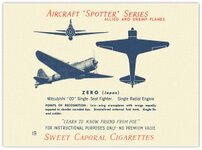The wing structure of the A6M bears no commonality with Northrop and Vought's construction, and while the fuselage design is closer, the Mitsubishi elegance is far superior.
Any comparisons with the Hughes H-1 are laughable structurally.
At best, one may muse that Japanese designers took inspiration from the cigarette pack 3-views popular those days, and based development by copying some cards that came in smuggled packs of Chesterfields.
Any comparisons with the Hughes H-1 are laughable structurally.
At best, one may muse that Japanese designers took inspiration from the cigarette pack 3-views popular those days, and based development by copying some cards that came in smuggled packs of Chesterfields.

